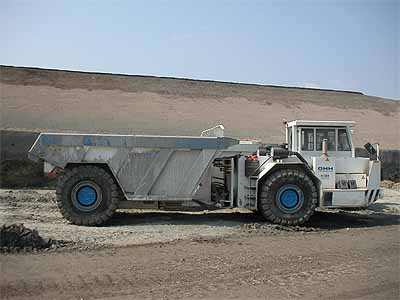GHH Fahrzeuge
GHH vehicle for growth
For over 40 years, GHH Fahrzeuge GmbH has established itself as a heavyweight in the production of mining and tunnelling vehicles, as well as aircraft movers and other bespoke industrial equipment.
The company has strengthened its reputation by reflecting the needs of the industries in which it deals. GHH makes sure its products are highly available in the markets required, and that its vehicles operate economically and safely. Safety of equipment within the mining and tunnelling industry is naturally a primary concern for the company, and managing director Guenther Saelhoff has contributed to the literature discussing innovations and solutions within mining and tunnelling, which demonstrates GHH’s commitment to further developments within the industry. This commitment saw the company reach a turnover of 30 million euros last year.
The emphasis within the company on research and design has been displayed at recent exhibitions of aircraft and mining technologies. For example, GHH displayed its latest products in the aircraft-moving vehicle market at the Airport Technologies and Infrastructure Exhibition TIL, in Poland. The company was keen to develop into the rapidly expanding Polish market, and the exhibition was the perfect environment to display GHH’s state-of-the-art vehicles. The company produces an array of aircraft movers, the smallest being the AM110 series, which move up to 130 tonnes, with the largest being the AM500 series, able to move up to 620 tonnes.
The expanding Polish market is also of interest to the company in regards to the mining industry. Boart Longyear Ltd sold its Polish Mining Capital Equipment division in 2006, and 30 per cent of the company was purchased by Schmidt, Kranz and Co., who has owned GHH since 1999. This acquisition has encouraged GHH’s continued growth in the mining vehicle market, as a producer of load haul dumpers (LHDs) and rear-end dumpers.
The company prides itself on cutting edge vehicle designs that have been developed in relation to the demands of the mining industry. LHDs have been designed especially for confined spaces and low headroom, and the safety of the driver is optimum. This can be seen in features like a sidewise positioned driver’s cab, which ensures safety and allows the vehicle to be driven both forwards and backwards. The LHDs have permanent four wheel drive and centre articulation as standard, and can transport payloads between three and 20 tonnes.
Coupled with this compact yet efficient design is GHH’s commitment to creating environmentally sound vehicles. This is notable in the fact that its LHDs are powered by electricity, so that underground environments are not filled with smoke and engine fumes. This factor is also acknowledged in the design of the company’s rear-end dumpers, which have air and water cooled diesel engines coupled with an exhaust cleaning system. To ensure that its products have a maximum life span, GHH offers an array of support services to its customers. It offers spare parts storage proposals and customer-orientated parts storage onsite, as well as providing technical documentation on CD ROM, and spare parts information via the internet as part of its ePartS service.
GHH’s LF-4.4 load haul dumper was the company’s bestseller in 2006, shifting more than 50 units worldwide, mainly to South Africa. For example, the Kroondal platinum mine has 71 GHH vehicles working, loading and transporting 600,000 megatons a month of run-of-mine ore. Succeeding the LF-4.2 ‘Aardvark’ model, the LF-4.4 offers a low profile with a bigger bucket capacity, increasing production by 22 per cent on sites where both models had been used. The company is keen to expand into markets where mechanised mining is developing, and in South Africa, two major complexes are responsible for 70 per cent of the world’s platinum and chromium supplies.
In a June 2006 paper for the Rapid Mine Development symposium, Guenther Saelhoff comments on the market’s progress: “Southern Africa has been converted to mechanised systems to a great extend, and the conversion will continue to take place in stooping height of 1.5 metres and more. Low profile equipment has not only increased the production but also improved the safety when compared with conventional mining. The height limit of low profile LHDs is basically defined by tyres size, and mining below 1.5 metre stooping height requires both new mining concepts as well as new LHD concepts.” Indeed, the future of mining vehicles is being examined, with Guenther revealing two areas of focus – namely, remote controlled machines with high-speed crawlers, and vibrating buckets.
The potential difficulties that GHH faces are expanding at the same rate that components can be provided. To encourage better service to its customers, the company relocated to Gelsenkirchen in April 2007 from its old site at Oberhausen. This shift to a modern production and communication facility has strengthened GHH’s market position, improving the quality assurance on its products, as well as displaying faster reaction times. Customers will be able to witness the company’s latest productions in aircraft moving vehicles at the Munich Inter Airport Europe exhibition, October 2007. It is clear that steady expansion and commitment to product development is at the heart of GHH’s plans for the future.
GHH Fahrzeuge
Products: Mining, tunnelling, and aircraft-moving vehicles
Sites: Germany, China, Russia and South Africa
Employees: 220
www.ghh-fahrzeuge.de
